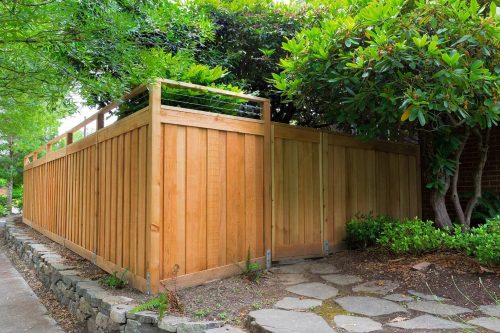The difference between stain and paint.
Before deciding which to use on your fence, you should be aware of a few critical differences between stain and paint. First, paint provides a solid, opaque color that covers the wood beneath it. Stain, on the other hand, penetrates the wood grain and allows the natural beauty of the wood to show through.
Another key difference is that paint will typically last longer than stain. This is because paint forms a protective barrier on the wood’s surface that helps resist UV rays, moisture, and other environmental factors. Color does not provide this same level of protection, so it will generally need to be reapplied more often.
Finally, paint is usually more expensive than stain. This is because it takes more labor to apply and requires specialized equipment. Color is generally much easier to use and can be done with basic painting supplies.
When to use paint and when to use stain.
A few key differences between paint and stain will help you decide which is the best option for your fence. First, paint provides a solid color coating that covers the surface it is applied to. This can be helpful if you are trying to cover up an old, faded fence or blend in with your home’s siding. Stain, on the other hand, works by soaking into the wood and highlighting its natural grain. This can give your fence a more natural look that complements your landscaping.
Another critical difference between paint and stain is durability. Paint is more resistant to fading, peeling, and cracking, making it a good choice if you live in an area with harsh weather conditions. Stain is more vulnerable to these types of damage, but it can be easily touched up if necessary.
Finally, you’ll need to consider the cost of each option. Paint is typically more expensive than stain, but it will last longer. Stain is a less expensive option, but you may need to reapply it more often to keep your fence looking its best.
Whatever option you choose, follow the manufacturer’s instructions carefully to ensure the best results.
What type of fence is each best for?
Paint is for smooth surfaces, while stains are for porous or textured surfaces. Color provides a thicker layer of protection and is more durable than a stain, but it can also be more challenging to apply evenly. Dye penetrates the wood fibers and provides long-lasting protection from the elements, but it may need to be reapplied more often than paint.
When deciding whether to paint or stain your fence, consider the type of wood and the level of protection you need. Paint is the best option if you want a durable finish that will last for years. Staining is the way to go if you prefer a natural look that can be easily touched up.
No matter which route you choose, proper preparation is key to ensuring a long-lasting finish. Be sure to clean the fence and repair any damage before applying paint or stain. Once you’ve chosen your product, follow the manufacturer’s instructions carefully to ensure the best results.

How to apply paint or stain to a fence.
When choosing a finish for your fence, you have two main options: paint or stain. Both have benefits and drawbacks, so choosing the one that best suits your needs is essential.
Paint is a good option if you want to cover the wood and achieve a uniform look ultimately. It’s also easy to apply and touch up and relatively inexpensive. The downside is that paint can chip and peel over time and doesn’t offer much protection against the elements.
Stain, on the other hand, penetrates the wood and leaves the grain visible. It’s a good choice if you want to show off the natural beauty of the wood. Stain is also more durable than paint, protecting the elements. The downside is that it can be challenging to apply evenly and may require more frequent reapplication.
The benefits of using each one.
Paint is a good option if you want to cover the wood and achieve a uniform look ultimately. It’s also easy to apply and touch up and relatively inexpensive. The downside is that paint can chip and peel over time and doesn’t offer much protection against the elements.
Stain, on the other hand, penetrates the wood and leaves the grain visible. It’s a good choice if you want to show off the natural beauty of the wood. Stain is also more durable than paint, protecting the elements. The downside is that it can be challenging to apply evenly and may require more frequent reapplication.
No matter which option you choose, proper preparation is key to ensuring a long-lasting finish. Be sure to clean the fence and repair any damage before applying paint or stain. Once you’ve chosen your product, follow the manufacturer’s instructions carefully to ensure the best results.
Which one should you choose for your fence?
There are a few things to consider when deciding which type of fence is right for you. The most crucial factor is usually budget – wood fences are more expensive than chain links, for example. But there are other considerations, such as the overall look you’re going for and how much maintenance you’re willing to do. Here’s a quick rundown of the different types of fences and their pros and cons:
Wood Fences: Wood is the classic choice for fences, and for a good reason – it’s strong, durable, and looks great. However, it does require more maintenance than other materials (such as painting or staining), and it can be susceptible to rot if not properly cared for.
Chain Link Fences: Chain link fences are popular for residential and commercial properties. They’re relatively inexpensive and easy to install and offer good security. However, they’re not as attractive as other fence types and can be prone to rusting over time.
Vinyl Fences: Vinyl fences are gaining in popularity due to their low maintenance requirements and attractive appearance. They’re also durable, although they can be more expensive than wood or chain link fences.
Aluminum Fences: Aluminum fences offer a similar look to wrought iron fences but without a high price tag. They’re also low maintenance and resistant to rusting. However, they’re not as strong as other fence types, so there may be better choices for properties that require a high level of security.
These are just a few of the most popular fence types – there are many others to choose from. The best way to decide which is right for you is to consult a fencing professional who can help you assess your needs and find the perfect fence for your property.
Conclusion.
Pivot Cedar Fencing of Maple Ridge is a fence contractor specializing in cedar fencing. They are located in Maple Ridge, BC, and have been in business for years. Pivot Cedar Fencing is a family-owned and operated business, and they take pride in their artistry and customer service. Pivot Cedar Fencing is bonded, insured, and licensed, and they offer a wide variety of services, including fence installation, repair, and replacement. Pivot Cedar Fencing is dedicated to providing its customers with the highest quality products and services available, and they stand behind its work with a 100% satisfaction guarantee. Pivot Cedar Fencing is the fence contractor you can trust for all your cedar fencing needs. Give them a call today!


